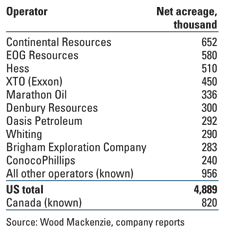Reagan R. Dukes, Wood Mackenzie
The Bakken Shale is defining the future of unconventional oil development in the United States. Wood Mackenzie estimates that 14 of the largest operators in the basin have commercial reserves greater than 1.3 billion bbl. In 2008, the US Geological Society estimated that technically recoverable reserves could reach as high as 4.3 billion bbl. This makes the Bakken the single largest continuous oil accumulation ever assessed by the US agency.
Ten years have passed since Lyco Energy hydraulically fractured a vertical Bakken well at Elm Coulee Field in Richland County, Montana. The oil boom has since spread across the basin. For decades, the formation was considered the source rock for conventional oil fields in the Williston Basin. The tight, thin and organic-rich middle member of the shale has been developed from a local anomaly at Elm Coulee to the target of prolific fields such as Parshall and Sanish in North Dakota. Well results indicate that these three fields are just the beginning of the oil boom.
The full commercial extent of the play is yet to be defined, as operators test wells throughout much of eastern Montana and western North Dakota. Development of the play mirrors experiences in the gas shale plays. Horizontal drilling combined with next-generation hydraulic fracturing techniques are opening up more acreage than even the most optimistic operator would have predicted a few years ago.
Many touted the potential, but few expected to surpass 100 active rigs in the Bakken by March 2010. The rig count dropped below 40 in May 2009, but as oil prices recovered, it began a dramatic rise over the next year. The 104 active rigs this April represent more than 25% of the active onshore oil rigs in the US. If oil prices remain in line with Wood Mackenzie’s long-term forecast of more than $80/bbl, North Dakota could challenge the all-time record of 146 rigs active in 1981. Even at just $40/bbl, operators should realize a 10% pre-tax rate of return.
Operators have expanded in every direction and drilled successful wells in areas once deemed too tight. A recent well was brought on in Williams County, North Dakota, at a 24-hour production rate of 5,100 boepd. The well results are being driven by the advent of “super fracs” that can include more than 40 stages along a 10,000-ft horizontal lateral, which are gradually displacing 5,000-ft laterals and openhole frac completion designs with planned re-fracs.
In the US, operators have leased more than 5 million acres considered prospective for the play (see table). More than 70 companies operate US Bakken wells, and 36 have an active rig in the basin as of April 2010. Almost a million acres have been leased in Canada. As exploration and development advance, not only have less-explored areas proved commercial, but operators are also successfully drilling the underlying Three Forks-Sanish (TFS) Formation. Well results in this zone have been better than in the Bakken at certain areas of the basin, and wells have been tested that target both formations through dual laterals. The TFS Formation covers a larger area within the basin, and a portion of the play is being developed where the Middle Bakken member is not present.
| TABLE 1. Bakken acreage holders |
 |
From relatively nothing in 2000, production from the Bakken will surpass 200,000 bpd in 2010. The Williston Basin is expected to produce about 332,000 bpd for the year. In Wood Mackenzie’s latest projection, Williston production will eclipse 400,000 bpd in 2014 and, with recent rig additions, this estimate could be pushed even higher. If current activity levels hold, production from the basin will likely grow to over 500,000 bpd in that same timeframe, and at this level would account for about 20% of US onshore oil production.
To date, oil export capacity out of the region has kept pace with production, but additional expansions are needed to support the basin’s growth. Oil pipeline capacity in the basin is about 334,000 bpd, with an estimated 100,000 bpd of rail capacity. Under our current production forecast and considering the utilization of rail facilities, pipelines will approach capacity at year-end 2011.
Additional rail agreements could provide that needed capacity. EOG Resources’ 60,000-bpd rail facility in Minot, North Dakota, is expected to return better netbacks than local pipelines. Potential pipeline projects may also add more than 350,000 bpd of capacity by 2013. The projects range from local expansions to possible connections with TransCanada’s Keystone pipelines.
As companies plan export capacity, the play continues to outperform expectations. Multistage fracs coupled with long laterals are expanding the economic limits of this unconventional oil play. Development will continue for years and lead into large-scale secondary and tertiary recovery projects.
The success of the Bakken is unparalleled in North America, but a looming question remains: Where else can this be replicated? Operators are in the early stages of transferring these techniques to the Niobrara oil play of the Rocky Mountains and the Eagle Ford Shale of the Gulf Coast. This is just the beginning, as leasing and drilling have picked up in liquids-rich plays from North Dakota all the way to France. C’est la vie! 
|
THE AUTHORS
|
 |
Reagan T. (R.T.) Dukes is the Lead Analyst in Wood Mackenzie’s Rocky Mountains upstream research team. He is also involved with numerous domestic consulting projects ranging from asset opportunity screenings to strategic reviews. Mr. Dukes graduated cum laude from Texas A&M University with a bachelor’s degree in accounting and a master’s degree in finance.
|
|




